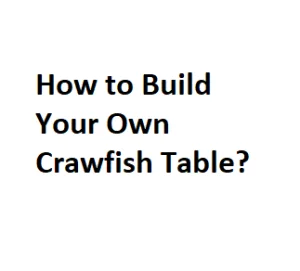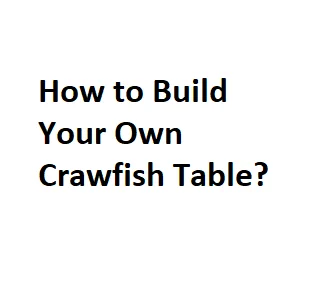There’s something special about gathering friends and family for a crawfish boil on a sunny day. The enticing aroma, the lively atmosphere, and the delicious taste of freshly boiled crawfish make for an unforgettable experience. To elevate your outdoor feasting game, why not build your own crawfish table? In this step-by-step guide, we’ll walk you through the process of creating a customized crawfish table that not only serves its purpose but also adds a personal touch to your gatherings.
Materials Needed:
- Wooden Planks: Choose a sturdy, weather-resistant wood like cedar or pressure-treated pine for the tabletop. Ensure the dimensions fit your desired table size.
- Table Legs: Opt for four table legs that provide stability and are suitable for outdoor use. You can find these at your local hardware store.
- Screws and Nails: Invest in corrosion-resistant screws and nails to ensure the longevity of your crawfish table.
- Wood Glue: Use wood glue to reinforce joints and enhance the overall strength of your table.
- Waterproof Sealant or Stain: Apply a waterproof sealant or stain to protect the wood from the elements. This step also adds an aesthetic touch to your table.
- Cup Holders: Incorporate cup holders into the design for added convenience. These can be purchased or crafted using PVC pipe.
- Mesh or Wire Basket: To facilitate easy cleaning, attach a removable mesh or wire basket beneath the table to catch discarded shells and debris.
- Tools: Gather essential tools such as a saw, drill, screwdriver, and measuring tape.
Step-by-Step Guide:
- Design Your Table: Sketch a design for your crawfish table, considering dimensions, features, and any additional elements you want to include.
- Cut the Wood: Use a saw to cut the wooden planks according to your design. Ensure precision to guarantee a well-fitted table.
- Assemble the Tabletop: Arrange the cut planks to form the tabletop. Apply wood glue to the joints and secure them with screws. This will create a durable and stable surface for your crawfish boils.
- Attach the Legs: Fix the table legs to the tabletop using screws. Ensure they are evenly distributed to provide adequate support.
- Add Cup Holders: If you’ve opted for cup holders, attach them to the sides of the table. Measure and cut PVC pipe to the desired length, securing them in place with screws.
- Apply Waterproof Sealant or Stain: Coat the entire table, including the legs, with a waterproof sealant or stain. This step not only protects the wood but also enhances its appearance.
- Attach the Basket: Beneath the tabletop, attach a mesh or wire basket using screws. This will catch crawfish shells and other debris, making cleanup a breeze.
- Test and Make Adjustments: Before showcasing your crawfish table at a big gathering, take the time to test its stability and functionality. Place a weight equivalent to the expected load during a crawfish boil on the tabletop. This ensures that the table can handle the weight without any wobbling or strain on the joints. If you notice any issues, make the necessary adjustments, such as adding extra support or reinforcing weak points.
- Personalize Your Table: Add a personal touch to your crawfish table by incorporating unique features or decorations. Consider engraving your family name, adding a colorful finish, or attaching hooks for utensils. Personalization not only makes your table stand out but also creates a sense of ownership and pride in your DIY creation.
- Share Your Creation: Once your crawfish table passes the test, it’s time to share it with friends and family. Host a crawfish boil or outdoor gathering to unveil your masterpiece. Watch as your guests appreciate not only the delicious crawfish but also the thought and effort you put into crafting the perfect table for the occasion.
- Maintenance Tips: To ensure the longevity of your crawfish table, implement regular maintenance practices. Periodically check for signs of wear, especially in areas exposed to the elements. If you notice any damage, promptly address it by replacing or repairing the affected parts. Additionally, reapply a waterproof sealant or stain as needed to protect the wood from weathering.
- Document and Share Your DIY Journey: Capture the process of building your crawfish table through photos or videos. Share your DIY journey on social media or create a blog post to inspire others to embark on similar projects. Documenting your experience not only serves as a personal keepsake but also contributes to the online community of DIY enthusiasts.
- Explore Variations and Upgrades: Once you’ve mastered the basics of building a crawfish table, consider exploring variations and upgrades to enhance its functionality. Some enthusiasts add built-in coolers, cutting boards, or even umbrellas to their tables. Experimenting with new features can make your crawfish table not only a centerpiece for boils but also a versatile outdoor companion for various occasions.
- Build a Community: Connect with other DIY enthusiasts and crawfish boil aficionados. Share your experiences, exchange ideas, and learn from the journeys of fellow builders. Online forums, social media groups, or local DIY meetups can be valuable resources for inspiration and troubleshooting. Building a community around your shared passion can open doors to new ideas and collaborations.
- Consider Environmental Impact: As you embark on your DIY crawfish table project, consider the environmental impact of your choices. Opt for sustainable wood sources, eco-friendly sealants, and materials that align with your commitment to a greener lifestyle. Making conscious choices during the building process contributes to a more sustainable and responsible DIY project.
- Create a Build Kit for Others: If your crawfish table turns out to be a hit, consider creating a build kit for others interested in replicating your design. Compile a list of materials, tools, and a step-by-step guide. This not only helps fellow DIYers but also showcases your design to a wider audience.
- Evolve Your Design: As you gain more experience in DIY projects, revisit and evolve your crawfish table design. Perhaps you’ll discover new materials, innovative construction techniques, or aesthetic improvements. By continuously refining your design, you can create a legacy of craftsmanship that evolves over time.
- Share Your Recipe for Boil Success: Don’t limit your DIY prowess to the table alone; share your crawfish boil recipe and techniques with your community. The combination of a well-crafted table and an excellent boil recipe will solidify your reputation as the go-to host for unforgettable outdoor gatherings.
Materials
| No. |
Material |
Quantity |
Description |
Source |
| 1 |
Plywood |
1 sheet |
Tabletop |
Local Hardware Store |
| 2 |
2×4 Lumber |
4 pieces |
Table legs |
Lumber Yard |
| 3 |
Screws |
20 |
Securing tabletop and legs |
Hardware Store |
| 4 |
Chicken Wire |
1 roll |
Surface for holding crawfish and tools |
Home Improvement Store |
| 5 |
Hinges |
2 pairs |
Attaching foldable legs |
Hardware Store |
Tools
| No. |
Tool |
Quantity |
Description |
Source |
| 1 |
Saw |
1 |
Cutting lumber for table legs |
Local Hardware Store |
| 2 |
Screwdriver |
1 |
Securing screws and hinges |
Toolbox |
| 3 |
Staple Gun |
1 |
Attaching chicken wire to tabletop |
Home Improvement Store |
| 4 |
Measuring Tape |
1 |
Ensuring accurate dimensions |
Toolbox |
| 5 |
Drill |
1 |
Creating holes for screws and hinges |
Local Hardware Store |
Dimensions
| No. |
Element |
Measurement |
Description |
| 1 |
Tabletop |
4’x2′ |
Ideal size for a standard crawfish boil |
| 2 |
Table Legs |
2′ each |
Ensures a comfortable height |
| 3 |
Chicken Wire Surface |
4’x2′ |
Covers the entire tabletop |
| 4 |
Gap between Wires |
1″ |
Allows water drainage and easy cleaning |
| 5 |
Folded Table Height |
6″ |
Provides portability and storage |
Assembly Steps
| No. |
Step |
Description |
| 1 |
Cut Plywood |
Use saw to cut plywood into 4’x2′ tabletop |
| 2 |
Cut 2×4 Lumber |
Create four 2′ legs from the 2×4 lumber |
| 3 |
Attach Legs |
Secure the legs to the tabletop using screws |
| 4 |
Attach Hinges |
Connect hinges to enable table folding |
| 5 |
Add Chicken Wire |
Staple chicken wire to the tabletop securely |
| 6 |
Secure the Edges |
Ensure no sharp edges are protruding |
| 7 |
Test Folding Mechanism |
Confirm the table can be easily folded and unfolded |
| 8 |
Sand and Finish |
Smooth any rough surfaces for safety and aesthetics |
| 9 |
Paint or Seal |
Optionally, add a protective layer for longevity |
| 10 |
Final Inspection |
Check all components for stability and security |
Safety Tips
| No. |
Tip |
Description |
| 1 |
Wear Safety Gear |
Use safety glasses and gloves during construction |
| 2 |
Work in a Well-Ventilated Area |
Ensure good airflow when using paint or sealant |
| 3 |
Double-Check Measurements |
Confirm dimensions before cutting or attaching |
| 4 |
Mind the Sharp Edges |
Smooth edges to prevent injuries during handling |
| 5 |
Use Stable Work Surface |
Place the table on a stable surface during assembly |
| 6 |
Store Properly |
When not in use, store the table in a dry place |
| 7 |
Follow Tool Guidelines |
Adhere to the safety guidelines for each tool used |
| 8 |
Secure Folding Mechanism |
Ensure hinges are securely attached for stability |
| 9 |
Test Stability |
Before each use, check for any wobbling or issues |
| 10 |
Enjoy Responsibly |
Have fun, but also practice safety during crawfish boils! |
Conclusion:
Building a crawfish table is not just a one-time project; it’s a journey of creativity, community, and continuous improvement. From the initial sketch to the first gathering around your custom creation, each step contributes to a story that goes beyond the physical table. Embrace the process, welcome challenges as opportunities to learn, and savor the joy of sharing your craftsmanship with those you hold dear. Happy building, and may your crawfish tables be a symbol of countless joyous moments!

